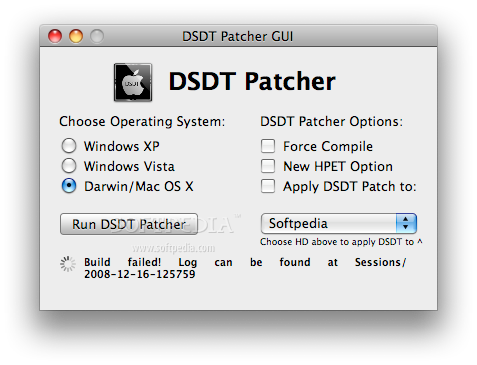DSDT.aml (Differentiated System Description Table) is a file used to tell OS X how to locate and enable features of your computer mainboard without checking of BIOS. It can be placed at the root of your system hard drive or in /Extra folder which depends on your installation method. It allows the user to open a DSL file or extract the DSDT from IOReg. Download Review Comments Questions & Answers We do not have a download file for the latest version (0.8), but you can try downloading it from the developer's site. Small and simple source code editor for Mac OS X. Related stories See all. Spotify is now allowing users to.
The Differentiated System Description Table is the main table in the ACPI part of a computer's BIOS.
The Advanced Configuration and Power Interface (ACPI) defines a large number of tables that provide the interface between an ACPI-compliant operating system and system firmware. These allow description of system hardware in a platform-independent manner in ACPI Machine Language (AML).
The problem is that OS X has an incomplete ACPI implementation which supports only a subset of DSDT. Modifying the DSDT allows the user to better support their hardware. For example, fixing Time Machine and the UUID 35 error is possible after modifying the DSDT.
To patch your DSDT, you must either use a new table file that someone else has provided, or extract and modify your own. Then tell your bootloader to use the new DSDT file instead of the BIOS. On a few motherboards it is also possible to replace the BIOS with an updated BIOS with a patched DSDT.
[edit]Extracting DSDT from BIOS
One of the simplest ways to extract your DSDT from your BIOS is by using DSDT Editor. Once you have downloaded DSDT Editor, open it and press File --> Extract DSDT. After 2-15 seconds, your DSDT should appear on the screen.
[edit]DSDT Patches
Having a patch for your motherboard is essential to create your own DSDT, if you couldn't find one online. A large collection of patches are available here: DSDT motherboard patches Assuming you followed the steps above to extract the DSDT from your BIOS, now we are going to apply the patch. Navigate to Patch --> Open, and choose the patch that you downloaded for your motherboard. Once the patch window pops up, press Apply. After a few seconds, navigate to IASL --> Compile . Once the window pops up, there may be a few errors. If so, press 'Fix Errors.' Once it's finished, you have your DSDT. Navigate to IASL --> Save AML As... , and save it as DSDT.aml .
[edit]Weblinks
- DSDT simple editor V1.4.3 - EvOsx86
- DSDT editor - El Coniglio
- DSDT Auto-Patcher - MaLd0n
- DSDT Patcher, a tool to fix your DSDT - InsanelyMac
- Iaslme Drag/Drop GUI for decompiler iasl - InsanelyMac
- MaciASL Native ACPI Machine Language IDE for OS X - Sourceforge
[edit] Sources for patched DSDTs
- Cartri from Brazil provides 'Mac Edition' BIOSes for Gigabite P43/P45 motherboards with a patched DSDT.[1]
- List of DSDT patches for the Asus P5E3 Premium (should work for most ASUS P5* motherboards) [2]
This page was last modified on 22 January 2018, at 03:20.
This page has been accessed 888,449 times.
Wiki
The DSDT (Differentiated System Description Table) is the main table in the ACPI part of a computer's BIOS.
The Advanced Configuration and Power Interface (ACPI) defines a large number of tables that provide the interface between an ACPI-compliant operating system and system firmware. These allow description of system hardware in a platform-independent manner in ACPI Machine Language (AML).

The problem is that OS X has an incomplete ACPI implementation which supports only a subset of DSDT. Modifying the DSDT allows the user to better support their hardware. For example, fixing Time Machine and the UUID 35 error is possible after modifying the DSDT.
To patch your DSDT, you must either use a new table file that someone else has provided, or extract and modify your own. Then tell your bootloader to use the new DSDT file instead of the BIOS. On a few motherboards it is also possible to replace the BIOS with an updated BIOS with a patched DSDT.
Preparations
- Setting Up on Windows
Install AIDA64
AIDA64 is a system information, diagnostics, and auditing program that runs on Microsoft Windows operating systems. It displays detailed information on the components of a computer. Information can be saved to file in formats such as HTML, CSV, or XML. Download and install AIDA64 from official website www.aida64.com
Open AIDA64 → Right Click → ACPI Tool → Save DSDT → Save DSDT As acpi_dsdt.bin

Save Table → Save SSDT As acpi_ssdt-1.bin, acpi_ssdt-2.bin, ...
Dsdt For Mac Os X 10.13
Video Debug → Video BIOS dump
Rename File
- Setting Up on OS X
Install DSDT Editor For Mac and Chameleon Wizzard on OS X. Note that DSDT Editor need to have Java Run Time support.
Use open DSDT Editor For Mac acpi_dsdt.aml, press F5 to compile, click Fix Errors, can't have Errors, Warning and Remarks can be temporarily ignored. No Error, save as DSDT.aml, use the same method to create SSDT.
- Chameleon Wizzard Basic Setting

Dsdt For Mac Os X64
Put DSDT.aml, SSDT.aml, and graphics rom to /Extra floder.
Dsdt For Mac Os X 10.10
Download
Dsdt Mac Os X
Chameleon Wizard v4.3.2.zip
DSDTEditor_Mac.zip
